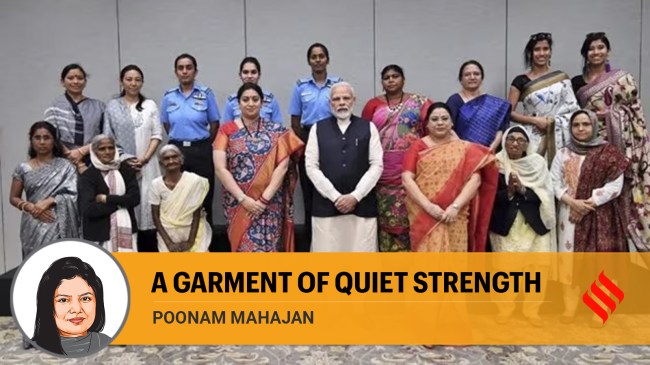Opinion From Rekha’s Kanjeevarams to Raw Mango, the timeless grace of saris
In contemporary India, the sari has become a garment of empowerment, a choice that defies Western norms. It is inclusive, embracing every woman in her natural form, a quiet rebellion against the impossible standards set for women today
 Set to commence at 8 am on December 10 at the Bandra Kurla Complex in Mumbai, the event co-organised by the Ministry of Textiles is themed “One Bharat Sari Walkathon — Diverse Threads, United Strides. (Express File Photo)
Set to commence at 8 am on December 10 at the Bandra Kurla Complex in Mumbai, the event co-organised by the Ministry of Textiles is themed “One Bharat Sari Walkathon — Diverse Threads, United Strides. (Express File Photo)
The Sari Walkathon is a movement to celebrate Indian women. It marries an age-old tradition with a fresh concept. Seen as a garment we wear every day, the sari’s true essence of strength and grace is often overlooked. The walkathon is not a pageant. It’s a show of nari shakti, a demonstration of how far we have walked and how far we intend to go. We will walk together as one to celebrate women from across India. With this symbolic two-km walk, we hope to inspire women to take charge of their minds, bodies and financial independence. Set to commence at 8 am on December 10 at the Bandra Kurla Complex in Mumbai, the event co-organised by the Ministry of Textiles is themed “One Bharat Sari Walkathon — Diverse Threads, United Strides”.
This elegant garment embodies a saga, spun from the ancient looms of tradition, enriched by regional diversity and infused with the enduring spirit of a nation. Archaeological findings from the Indus Valley Civilisation, especially the terracotta figurines from Mohenjo Daro and Harappa, depict a garment resembling the sari draped in a style akin to the modern Nivi drape. These early versions were likely made from cotton, a testament to the Indus Valley’s pioneering role in cotton cultivation and weaving. Each region of India breathes life into the sari in its unique way.
Benaras, perhaps India’s oldest city, is known for its regal silk sari whose intricate brocade draws from ancient lore. It is the most exported sari from India. The bright colours and temple designs of the Kanjeevaram, one of the oldest weaves from the south, Tamil Nadu, whisper tales of deities and age-old ceremonies.
In Bengal, the cotton Tant sarees tell a story of simplicity and grace while the Bandhani of Gujarat and Rajasthan bursts into a kaleidoscope of tie-dye patterns, each knot a testament to local legends and traditions. In my home state, Maharashtra, the Paithani sari is a testament to a rich weaving heritage. These saris are renowned for their luxurious silk and intricate zari work which features motifs like the mor (peacock) and kamal (lotus). One of my personal favourites is the Ahimsa silk also known as Eri silk — here sericulture practices respect the life cycle of the silkworm and offer an alternative narrative to traditional silk. It speaks of compassion and sustainability and is a statement against the cruelty often hidden in the folds of luxury.
The sari became less popular during the Mughal and British rule. During the freedom movement, Mahatma Gandhi championed the spinning of khadi. With his charkha, he was crafting more than just a fabric. He was weaving a tale of defiance, self-sufficiency and dignity. The khadi sari became a symbol of resistance, a garment of quiet strength worn by women who stood at the forefront of the freedom movement.
In contemporary India, the sari has become a garment of empowerment, a choice that defies Western norms. It is inclusive, embracing every woman in her natural form, a quiet rebellion against the impossible standards set for women today.
In upholding the sari’s enduring charm, actor Rekha stands out as an icon. Draped in the timeless grace of a sari, she embodies the essence of classic Indian beauty. As a child, I saw Rekha proudly wear her Kanjeevarams and gajra at award shows around the world, when other actors would be wearing Western outfits. Bollywood divas of the 1990s, swathed in the riotous colours of sarees twirling in Switzerland’s snow, presented a delightful dance of contrasts — India’s tropical drape meeting Alpine frost.
According to the Ministry of Textiles, over 11 million artisans, many of them women, earn their livelihood from making saris. At the Handloom School in Maheshwar, a project nurtured by the WomenWeave, young weavers are taught to balance the craft of intertwining tradition with the demands of a changing world. Then there’s the Saree Library by Border&Fall, an online repository preserving over 80 regional draping styles. Tisser, a non-profit, has a network of more than 10,000 artisans working on more than 100 art forms, and in 18 states.
This mission is also shared by Rouble Nagi who empowers artisans with her Studio Saksham and brings their products to market. Ekaya and Raw Mango are doing their bit to strengthen our textile traditions and are becoming exceedingly popular with women today. Nita Ambani recently launched Swadesh which is an ode to India’s craft traditions. I am confident that the lives of millions of weavers will be positively impacted by the project supported by the Reliance Foundation. Dolly Jain, has elevated the art of sari draping to effortless perfection.
Today, the lens with which we view a sari has transformed. It stands as a beacon of empowerment — it adorns a young lawyer in the courtroom and an Adivasi woman serving and defending her community. Each of us can embody the vision of the PM — women leading development. For me, it starts with beginning my day at work, amidst my constituents, donning the sari with pride. It symbolises my commitment to this cause and my connection to the rich tapestry of our heritage.
The writer is Member of Parliament, Lok Sabha from Mumbai North Central





